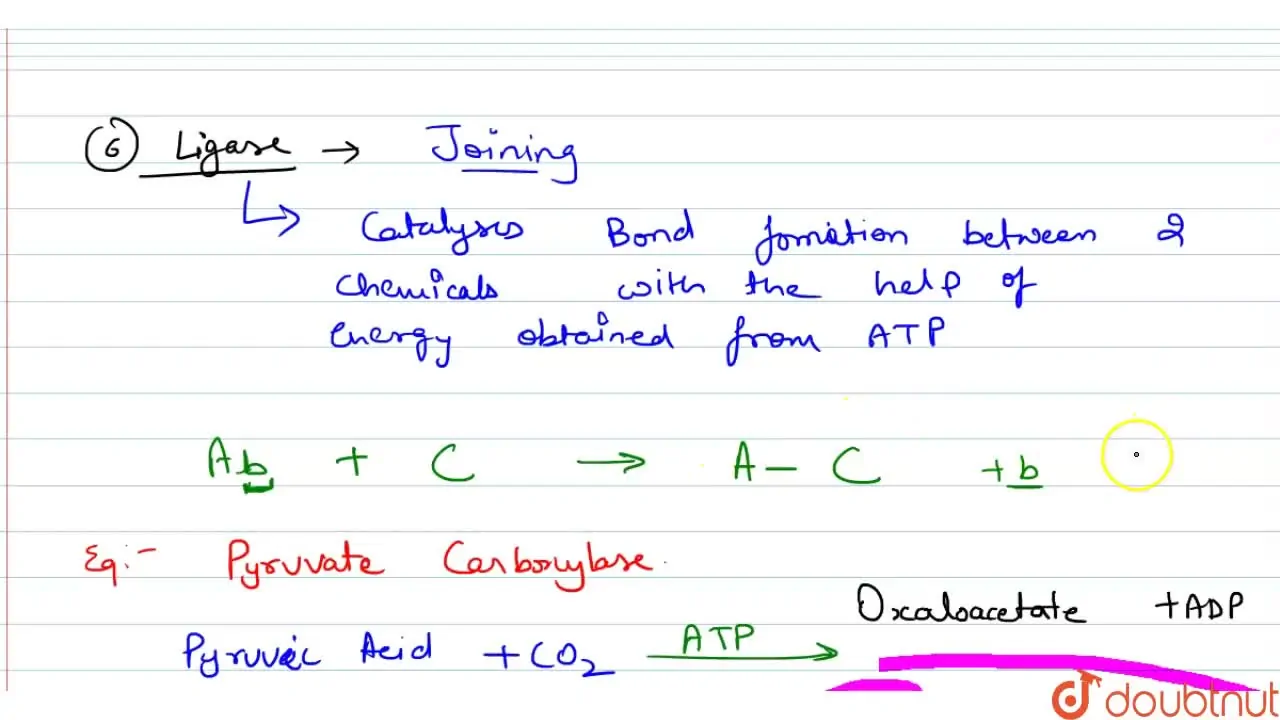What are different classes of enzymes? Explain any two with the type of reactions they catalyse.
Enzymes are divided into six classes each with 4-13 sub-classes and named accordingly by a four-digit number.
(i) Oxidoreductases/dehydrogenases These enzymes take part in oxidation and reduction or transfer of e−. S (reduced)+ S' (oxidised) → S (oxidised)+ S' (reduced)
(ii) Transferaes These enzymes transfer a functional group from one molecule to another (other than hydrogen). The chemical group transfer does not occur in free state.
S−G+S'Transferase−−−−−−→S+S'−G
(iii) Hydrolases These enzymes catalyse the hydrolysis of bonds like ester, ether, peptide, glycosidic C-C, C-halide, P-N etc.
C12 H22Maltose O11+H2OMaltase−−−−→2C6H12O6Glucose
(iv) Lyases These enzymes causes cleavage, removal of groups without hydrolysis and addition of groups to double bonds or removal of groups producing double bond.
X∣C−Y∣∣Clyase−−→X−Y+C=C
(v) Isomerases These enzymes cause rearrangement of molecular structure to effect isomeric changes. They are of three types. i.e., isomerases, epimerases and mutases.
Glucose-6-phosphateIsomerase−−−−−→Fructose 6- phosphate(Aldose to ketose group or vice-versa)
Glucose-6-phosphateMutase−−−→Glucose 1- phosphate(Shifting the position of side group)
Xylulose 5-phosphateEpimerase−−−−−→Ribulose-5-phosphate(Change in position of one constituent or carbon group)
(vi) Ligases are enzymes catalysing bonding of two chemicals with the help of energy obtained from ATP resulting formation of bonds such as C-0, C- S, C-N and p-O e.g., pyruvate carboxyl use
Ab+C→A−C+bpyruvate carboxylase
Pyruvric acid+CO2+ATP+H2O⇔Oxaloacetic+ADP+Pi-
Related Playlists
- BOOK - NCERT EXEMPLARCHAPTER - BIOMOLECULES EXERCISE - Short Answer Type Questions5videos
BIOMOLECULES
- BOOK - NCERT EXEMPLARCHAPTER - BIOLOGICAL CLASSIFICATIONEXERCISE - Long answer5videos
BIOLOGICAL CLASSIFICATION
- BOOK - NCERT EXEMPLARCHAPTER - Body Fluids and Circulation EXERCISE - LONG ANSWER TYPE Q5videos
Body Fluids and Circulation
Similar Questions
What are different classes of enzyme ? Explain any two with the type reaction they catalyse.
View SolutionWhat are different types of interactions? Explain.
View SolutionAssertion : Most of the enzymes have been classified into different groups based on the types of reactions they catalyse.
Reason : Enzymes are divided into 6 classes each with 4-13 subclasses and named accordingly by a six-digit number.View SolutionWhat are different types of combination reactions?
View SolutionWhat are the different types of chemical reaction ?
View SolutionWhat are the different types of nuclear reactions?
View SolutionWhat are the different types of nuclear reactions?
View SolutionWhat are twins ? Explain the two types of twins.
View SolutionWhat are twins ? Explain the two types of twins.
View SolutionExplain the different types of transpiration.
View Solution


